
2.2.6. Development
Overview
There are two development rollers in the development unit: the Toner Applica-
tion Roller and the Development Roller.
The toner supply bar [A] stirs and carries toner to the toner application roller
[B]. Toner is attracted to the toner application roller because it has a magnetic
layer. As the toner application roller turns past the toner metering blade [C],
only a thin coating of negatively charged toner particles stays adhered. (Refer
to section 4-4-2 of the Group 3 Facsimile manual.)
During printing, a bias voltage of -700 V is applied to the toner application
roller and another bias voltage of -400 V is applied to the development roller.
The toner is carried from the toner application roller to the development roller
[D] by the potential difference between these two rollers.
The exposed area on the drum [E] is at -100 V. The development roller ap-
plies toner to these areas of the latent image as they turn past the drum.
The development roller is made of a soft rubber so it does not damage the
surface of the drum. The development roller is provided as a separate spare
part because it always contacts the toner application roller, and so may be-
come dented.
The speed ratio between the drum, development roller, and the toner applica-
tion roller is about 1 : 1 : 3. The toner application roller rotates three times as
fast as the development roller, so it deposits a layer of toner three times as
thick on the development roller. This leads to a clearer image. Also, the toner
application roller rotates in the opposite direction to the development roller,
which helps to keep the toner level on the development roller.
[C]
[A]
[B]
[D]
[E]
H521D616.wmf
May 22nd, 1995
DETAILED SECTION DESCRIPTIONS
PRINTING
2-33
















































